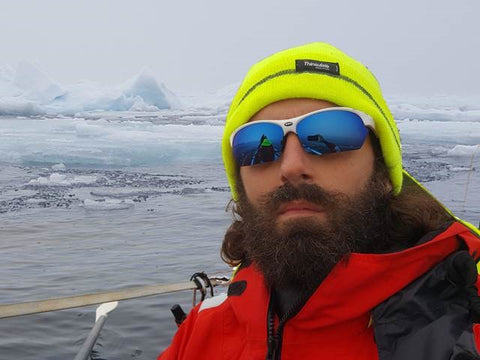
Carlo Facchino is no stranger to extreme conditions. In 2016 with a team of 4 he broke a world record for the fastest ro across the Pacific Ocean - Team Uniting Nations broke a Guinness World Record by rowing from Monterey, CA to Honolulu, HI in 39 days, 9 hours, and 56 minutes, a full three days faster than the existing record.
Now, Facchino and team have claimed another 11 records for their Polar Row from Tromsø, Norway to Iceland. They were going after the Longest Open Water Row in the Arctic and fell just short, but another 11 records is nothing to sneeze at. Teammate Fiann Paul became the most record breaking Ocean Rower, claiming the title of first to row 4 oceans, and first to hold speed record on 4 oceans.
Typing from his laptop in the airport in Oslow, Carlo Facchino gave us the run down on the epic journey, and how XX2i Optics helped make it possible.
We just finished our Polar Row and it was a huge success.
Some of the highlights: The Arctic Ice Shelf, Walrus, Whales, SVALBARD, dangerous seas, big waves, Guinness World Records and JAN MAYEN!

We broke up the expedition into three "legs" with the first leg rowing 521 nautical miles from Tromsø, Norway to Longyearbyen, Svalbard. The second leg we set off from Longyearbyen, Svalbard and attempted to row as far north as we possibly could. Just below 80º degrees north we ran into the Arctic ice pack and could go no further. It was quite the accomplishment to reach the ice pack and secure a record for the northernmost latitude (79º 55'55") ever reached by a rowing boat!
On reaching the Polar Ice Shelf: It was so cool! We were rowing and in the distance I could hear a low hum. Similar to being a bit away from the beach and hearing the hum of the waves. Then Alex said, what are those floating things as we were seeing little pebbles of ice float by. The pebbles turned to rocks to bigger chunks. The hum got louder. Then, there it was, Ice as far as we could see!!
The third leg of the trip started from the Arctic ice pack as we headed southwest toward Iceland. On the row south we passed several ice drifts which required some skillful navigation to get through. Several days after we passed the ice drifts the winds picked up and we rowed through a couple storms with rough seas. Conditions were constantly overcast and our solar panels weren't able to recharge our batteries. The batteries eventually drained and the electronics shut off. We rowed using manual steering and following a compass as we switched our route to stop at a very remote island called Jan Mayen in the Arctic. Jan Mayen is home to 18 Norwegians who live and work on a Norwegian Naval and Meteorological Station.

After reaching Jan Mayen and evaluating the boat along with the health of the crew and the remaining 300 plus miles to Iceland, we decided to end the expedition. The main concern was safety. The cold weather, wind chill, and cold waters were a huge concern. If we had capsized in a big wave, the potential for someone to die from hypothermia was very high. We are all very proud of our accomplishments and the records we earned.

Although we were in the Polar Day (24hour Sunlight) the conditions were usually overcast. The days when the sun was out, the XX2i Optics sunglasses were a HUGE help. During the Polar Day the sun is relatively low on the horizon and the glare is blinding. Having the polarized lenses was a huge bonus.
On our trip south to Iceland we hit multiple days with dense marine cover and no direct sunlight. Our solar panels weren't producing enough energy to power our batteries. At a certain point, the batteries could no longer power the electronics and we were forced to go without navigational equipment. We hit several big storms and the crew and boat took a beating. For several days we had to row by compass and manual steering. We headed toward Jan Mayen and successfully arrived on Aug. 21st.
Four of the six rowers decided the Arctic conditions were too unsafe - we've all been through dangerous conditions, but there are some days where you stop, and have to decide for yourself if you want to continue. The danger of capsizing in big waves and cold water, combined with the risk that hypothermia posed, meant that only a third of the team rowed onward. We all suffered from non-freezing cold injuries, mainly in our feet and hands. No frostbite, but it takes some time for the nerves to regenerate.
The remaining two rowers were welcomed at the Norwegian Naval and Meteorological Station on Jan Mayen, but there was no way for us to leave the island and we were stranded on the island for two weeks. Luckily, they had very limited internet access. This past Friday we were picked up by a Norwegian Coast Guard vessel and given a lift from Jan Mayen to mainland Norway. I'm currently at the airport in Oslo awaiting my flight home.
Signing off, Carlo Facchino.
We can't wait to see what the team does next!
Read more about the rowers on ITV.com
